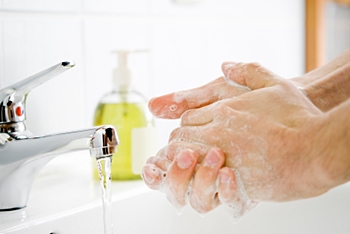 True soap or bathing bar? Industrially produced or handmade? Solid or liquid? Read on to learn more about soaps.
True soap or bathing bar? Industrially produced or handmade? Solid or liquid? Read on to learn more about soaps.
The best of them have exotic names, heavenly scents and attractive colours. Yet, the manufacturing of the toilet soap is a gooey affair.
Basically, you take greasy stuff and mix it with an alkaline agent. The greasy stuff can be of animal origin, such as tallow (beef or mutton fat), lard (pork fat), or even emu oil. Or it can be vegetable matter such as coconut oil, almond oil, cocoa butter, palm oil, shea butter, olive oil, avocado oil, jojoba oil, etc. Historically, ash was used as alkaline agent, while today we use lye (sodium or potassium hydroxide). After some water is added to the fat and the lye, the mixture is left to interact, a process called saponification, which can be cold or hot.
 As you can see, the story of the creation of the soap is not for the faint-hearted… I wouldn’t have even mentioned it if it were not for the fact that the production method largely determines the quality of the soap.
As you can see, the story of the creation of the soap is not for the faint-hearted… I wouldn’t have even mentioned it if it were not for the fact that the production method largely determines the quality of the soap.
A good soap must have good cleaning and lathering properties. It must also leave your skin feeling soft and hydrated. Those requirements are met when the soap contains a high proportion of fat, but not too high, as it will become mushy through constant contact with water.
A lot also depends on the heat factor. Cold saponification allows the soap to retain glycerine, making it gentle on the skin. However, this process takes a lot of time and is used exclusively for handmade soaps. Industrially manufactured toilet soaps use the much faster hot saponification which produces soaps that clean well, but can leave the skin feeling dry.
 For a long time, toilet soaps were our only choice when it came to personal hygiene. Today, we have a variety of other cleansers. Bathing bars usually have glycerin or moisturising milk added to them. Strictly speaking, bathing bars are not technically soaps, because they have a low fat content. Liquid washing products are usually considered true soaps. They were originally used for hand washing, but have since made their way into our showers. The market now offers a rich variety of liquid soaps and shower gels, as well as a plethora of natural or homemade soaps.
For a long time, toilet soaps were our only choice when it came to personal hygiene. Today, we have a variety of other cleansers. Bathing bars usually have glycerin or moisturising milk added to them. Strictly speaking, bathing bars are not technically soaps, because they have a low fat content. Liquid washing products are usually considered true soaps. They were originally used for hand washing, but have since made their way into our showers. The market now offers a rich variety of liquid soaps and shower gels, as well as a plethora of natural or homemade soaps.
So, what to use? That is a matter of personal preference. I am equally happy with liquid soap and toilet soap for washing hands. For showering, I reach for a bathing bar when my favourite handmade soap runs out, but won’t turn up my nose at a shower gel either.
What are your favourite hand and body cleansing products?









